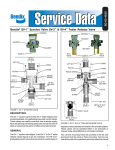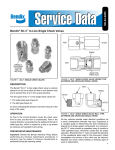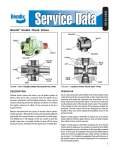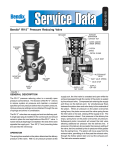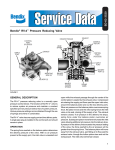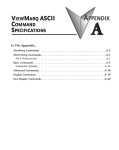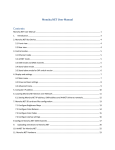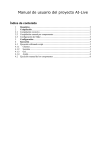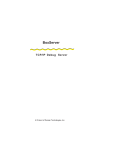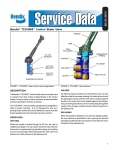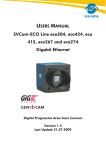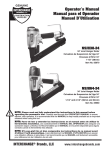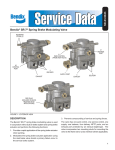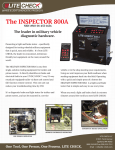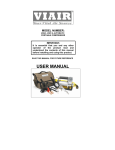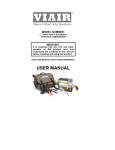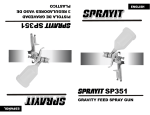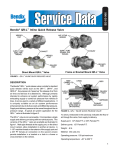Download BENDIX BW2578 User's Manual
Transcript
SD-03-3625 Bendix® TW-12™ Control Valve CONTROL CABLE CONNECTION LEVER CAM LEVER PIVOT LEVER CAM LEVER CAM PIVOT LEVER YOKE CAM FOLLOWER MOUNTING HOLE (2) 1/8" P.T. RETURN PORT 1/4" P.T. SUPPLY PORT LEVER YOKE PLUNGER CAP NUT 1/4" P.T. DELIVERY PORT PISTON PISTON O-RING PISTON RETURN SPRING RETURN PORT SUPPLY PORT CAP NUT PISTON RETURN PASSAGE DELIVERY PORT INLET VALVE CAP NUT O-RING INLET VALVE SPRING SUPPLY PORT TM FIGURE 1- TW-12 CONTROL VALVE DESCRIPTION The TW-12™ control valve is a manually operated, nongraduating, on-off valve. It is extensively used in hydraulic braking systems to control devices that are responsible for the application and release of the parking brakes. Note: The TW-12™ control valve can also be used in air brake system applications. The most common configuration of the TW-12™ control valve uses a levered cam that is manually, remote controlled. A dash mounted lever or button may be connected to the aluminum lever cam via Bowden cable control or connected directly to the transmission selector. Two .28 inch mounting holes are provided in the die cast zinc body for panel or frame mounting. Two steel hex cap nuts at the ends of the cylindrical valve body retain the internal components and provide attachment for the lever cam. All connection ports are pipe threads. Lettering embossed in the valve body identifies two of the three ports in the valve. Refer to the following chart and figure one. Connection Body Ident. Thread Sizex Supply SUP 1/4" P.T. xx Delivery DEL 1/4" P.T. xx Vent NONE 1/8" P.T. xx OPERATION SYSTEM CONNECTIONS Although the TW-12™ valve can be used in a variety of different systems and connected in different ways, figure 2 illustrates a typical hydraulic parking brake system. In this system the TW-12™ valve controls an HR-1™ hydraulic relay that in turn applies and releases hydraulic spring brakes. VALVE OPERATION Parking Brakes Applied With hydraulic fluid flowing to the supply port (Figure 1) and the piston in the upward position, fluid flow into the TW-12™ control valve is stopped at the closed inlet valve. 1 IN POWER STEERING GEAR OUT OUT IN RETURN HYDRAULIC BRAKE BOOSTER MASTER CYLINDER TW-12™ CONTROL VALVE IN HYDRAULIC SPRING BRAKE ACTUATOR TO SERVICE BRAKES DELIVERY SUPPLY SUPPLY CONTROL DELIVERY RETURN HYDRAULIC RESERVOIR RETURN DELIVERY HR-1™ HYDRAULIC RELAY HYDRAULIC SPRING BRAKE ACTUATOR RETURN POWER STEERING PUMP IN OUT FIGURE 2 - TW-12™ CONTROL VALVE HYDRAULIC PARK SYSTEM The TW-12™ valve delivery port is open to its return port through a passage in the center of the piston. Parking Brakes Released When the TW-12™ control valve plunger is depressed by the cam action of the lever (Figure 1) the piston contacts the inlet valve, closing the return passage. Continued piston movement pushes the inlet valve off its seat in the body, allowing hydraulic fluid to flow through the valve and out the delivery port. SERVICE CHECKS GENERAL Read the "General Safety Guidelines" presented in this manual before beginning any testing or service procedure. With the TW-12™ control valve installed in the vehicle brake system, proper valve operation can only be observed by the reaction of the system and components controlled by the TW-12™ valve. If malfunction or internal leakage is suspected or specific operational and leakage testing is desired, the TW-12™ valve must be removed and bench tested. Bench testing of the TW-12™ valve is accomplished using air pressure regardless of its application or the braking media used in the vehicle brake system. OPERATING AND LEAKAGE TESTS Function test the TW-12™ valve while it is installed in the system by starting the engine and warming the vehicle brake system for 5 minutes. Move the lever cam from one extreme 2 position to the other three times and observe that the components controlled by the TW-12™ control valve function promptly to the ON then OFF condition. Inspect the exterior of the TW-12™ valve. If the TW-12™ valve is used to control hydraulic brakes, no fluid leakage should be noted. Pay particular attention to the area around and beneath the lever cam. 1. When bench testing the TW-12™ control valve, attach a small reservoir volume to the delivery port with an air gauge installed. Note: 6-8 feet of ½” tubing or hose could be used in lieu of a small reservoir. 2. Apply a 120psi air pressure source to the supply port and move the lever cam to the applied and released position three times. Note that delivered air pressure is the same as supply air pressure in the applied position and that air is promptly exhausted in the released position. 3. With the TW-12™ control valve in the released position and 120psi at the supply port, apply a soap solution to the return port and around the supply port cap nut. Leakage should not exceed a 1” bubble in less than 5 seconds (100 SCCM) at the return port. No leakage is permitted at the cap nut. 4. Place the valve in the applied position and again apply a soap solution to the return port. Leakage should not exceed a 1” bubble in less than 5 seconds (100 SCCM) at the return port. 5. With 120psi applied to the supply and return ports simultaneously, apply a soap solution around the plunger and cam follower in the yoke assembly. Leakage should not exceed a 1” bubble in less than 5 seconds (100 SCCM). If the TW-12™ valve does not function as described or if excessive leakage is detected, it is recommended that it be replaced with a genuine Bendix® service replacement. PREVENTIVE MAINTENANCE Important: Review the Bendix Warranty Policy before performing any intrusive maintenance procedures. A warranty may be voided if intrusive maintenance is performed during the warranty period. No two vehicles operate under identical conditions, as a result, maintenance intervals may vary. Experience is a valuable guide in determining the best maintenance interval for system components. At a minimum the TW-12™ valves should be inspected every 6 months or 1500 operating hours, whichever comes first. 1. Check the TW-12™ control valve for proper operation. 2. Inspect the exterior of the valve for signs of leakage and any apparent physical damage. 3. Inspect the control cable and its connection point to the lever cam for damage and wear. If the TW-12™ control valve does not function as required or if leakage excessive, wear, or damage is noted during inspection, replace the valve with a genuine Bendix® service replacement unit. GENERAL SAFETY GUIDELINES - WARNING! PLEASE READ AND FOLLOW THESE INSTRUCTIONS TO AVOID PERSONAL INJURY OR DEATH: When working on or around brake systems and components, the following precautions should be observed at all times: 1. Park the vehicle on a level surface, apply the parking brakes, and always block the wheels. When working around or under the vehicle, stop the engine and remove the key from the ignition. Always keep hands away from chambers as they may apply as system pressure drops. Always wear safety glasses. 2. When working in the engine compartment, the engine should be shut off and the ignition key should be removed. Where circumstances require that the engine be in operation, EXTREME CAUTION should be used to prevent personal injury resulting from contact with moving, rotating, leaking, heated or electrically charged components. 3. Do not attempt to install, remove, disassemble or assemble a component until you have read and thoroughly understand the recommended procedures. Use only the proper tools and observe all precautions pertaining to the use of those tools. 4. Following the vehicle manufacturer’s recommended procedures, deactivate the electrical system in a manner that safely removes all electrical power from the vehicle. 5. If the vehicle is equipped with an air over hydraulic brake system or any auxiliary pressurized air system, make certain to drain the air pressure from all reservoirs before beginning ANY work on the vehicle. If the vehicle is equipped with an AD-IS® air dryer system or a dryer reservoir module, be sure to drain the purge reservoir. 6. Never connect or disconnect a hose or line containing pressure; it may whip. Never remove a component or pipe plug unless you are certain all system pressure has been depleted. 7. Never exceed manufacturer’s recommended pressure. 8. Never attempt to disassemble a component until you have read and understand all recommended procedures. Some components contain powerful springs and injury can result if not properly disassembled. Use only proper tools and observe all precautions pertaining to use of those tools. 9. Use only genuine Bendix ® replacement parts, components and kits. A. Use only components, devices and mounting and attaching hardware specifically designed for use in hydraulic brake systems. B. All replacement hardware, tubing, hose, fittings, etc. must be of equivalent size, type and strength as the original equipment. 10. Components with stripped threads or damaged parts should be replaced rather than repaired. Do not attempt repairs requiring machining or welding unless specifically stated and approved by the vehicle and component manufacturer. 11. Prior to returning the vehicle to service, make certain all components and systems are restored to their proper operating condition. VALVE REMOVAL 1. Park the vehicle on a level surface and block the wheels and/or hold the vehicle by means other than the service brakes. 2. Remove pressure from the vehicle service and parking brake system. In the case of a hydraulic brake system consult the vehicle manual for proper procedures to be followed. 3. Identify and mark or label all lines and their respective connections on the valve to facilitate ease of installation. 3 4. Disconnect all lines and the control cable from the lever cam. 5. Remove the valve from the vehicle. VALVE INSTALLATION 1. Install all line fittings and plugs making certain thread sealing material, if used, does not enter the valve. 2. Install the valve on the vehicle. 3. Reconnect all lines to the valve using the identification made during VALVE REMOVAL (step 3). Reconnect the control cable to the lever cam. 4. After installing the valve, test all fittings for excessive leakage and tighten as needed. 5. Perform operational and leakage inspections prior to returning the vehicle to service. In the case of a hydraulic brake system consult the vehicle manual for proper procedures to be followed. 4 BW2578 © 2006 Bendix Commercial Vehicle Systems LLC. 6/2006 Printed in U.S.A. All rights reserved.




